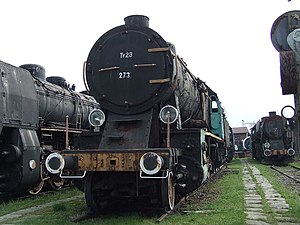PKP series Ty23
| PKP series Ty23 LBE G 12 DR series 58.6 / 58.23–27 SŽD Т У 23 (T U 23) |
|
|---|---|
| Numbering: | LBE 99-100; DR 58 601-602 (2301-2302) 58 2303-2772 |
| Type : | 1'E h2 |
| Length over buffers: | 20,065 mm |
| Service mass: | 95 t |
| Friction mass: | approx. 80 t |
| Wheel set mass : | approx. 16 t |
| Top speed: | 75 km / h |
| Indexed performance : | 1320 PSi / 970 kW |
| Starting tractive effort: | ≈ 231 kN |
| Driving wheel diameter: | 1,450 mm |
| Impeller diameter front: | 1,000 mm |
| Cylinder diameter: | 650 mm |
| Piston stroke: | 720 mm |
| Boiler overpressure: | 14 bar |
| Grate area: | 4.5 m² |
| Superheater area : | 73.5 m² |
| Evaporation heating surface: | 223.9 m² |
The locomotives of the series Ty23 of the Polish State Railways PKP are freight locomotives with the wheel arrangement 1'E.
The locomotives, which are similar to the Prussian G 12 , were designed by Schwartzkopff in 1923 ; Except for the boiler and the bar frame, however, they had little in common with the model. Unlike the G 12, they had a twin engine. The diameter of the driving wheels was 1450 mm slightly bigger, and the speed limit stood at 75 km / h to 10 km / h higher than the G 12. The Tender 2'2 'T 21.5 was of Polish design.
Schwartzkopff delivered 15 locomotives to the PKP. Cockerill and St. Leonard supplied a further 60 machines in Belgium until production was finally transferred to the Polish steam locomotive factory Fablok in Chrzanów . In total, more than 600 of these locomotives were built; it was the most numerous series in Poland.
Schwarzkopff had built two more locomotives with the serial numbers 8442 and 8443 in 1924 in anticipation of another order from the PKP. The order did not materialize, however, and the locomotives were only sold to the Lübeck-Büchener Eisenbahn (LBE) in 1935 . These were the last LBE locomotives with a tender, and they were given the class G 12 and the numbers 99 and 100. Since Schwartzkopff had not found a buyer for a long time, they were reasonably priced at RM 75,000 each. Initially they were used for heavy trains on the Lübeck – Büchen route, but after the Rothenburgsort turntable was extended, they could also be used on the Hamburg Railway .
When the LBE was taken over by the Deutsche Reichsbahn in 1938 , the two locomotives were classified as class 58.6 and were given the numbers 58 601 and 58 602.
During the occupation of Poland in World War II , the Reichsbahn 467 Ty23 took over and classified it as class 58.23-27 . These were given the company numbers 58 2303 to 58 2741. The former PKP-Ty23s taken over by the SŽD were given the company numbers 58 2742 to 58 2772. The two former LBE locomotives were renamed 58 2301 and 58 2302. Later they were relocated to the Reichsbahndirektion Osten (58 2301) and the Ostbahndirektion Warsaw (58 2302). In the broad gauge network of FBW Roslavl of FEKdo 2, the vice spurts from the SZD Ty23-614 for running railway troops of the Wehrmacht . This was not classified as 58.23-27 at the Deutsche Reichsbahn and kept its original name. This led to tensions with the Reichsbahn, as it could not have such locomotives, but had to maintain and drive them. The same was true for Ty23-178, which was captured in Przemyśl in 1941 . This was previously used briefly by the SŽD in the Lviv Railway Directorate in Eastern Galicia, which was newly founded in 1939 after the successful Soviet invasion of Poland . With the SŽD they were designated as the series Т У 23 (T U 23) and used during the German-Soviet War in the southern districts of the Turkestan-Siberia Railway .
After the Second World War, some locomotives remained with the Deutsche Reichsbahn in the GDR.
In Poland, the last Ty23s were in operation until the early 1980s.
See also
Web links
Individual evidence
- ↑ a b c d e f Witali Alexandrowitsch Rakow: Russian and Soviet steam locomotives . 1st edition. transpress, Berlin 1986, ISBN 3-344-00060-8 , pp. 243-245 .
- ^ Alfred Gottwaldt : The Lübeck-Büchener Railway. Private railway as a pioneer of new traffic technologies . 2nd Edition. alba, Düsseldorf 1999, ISBN 3-87094-235-5 , p. 67 & 114 .
- ^ Andreas Knipping, Ingo Hütter, Hansjürgen Wenzel: Locomotives "Home in the Reich". EK-Verlag, 2009, ISBN 978-3-88255-131-0 , pp. 419-428.
- ^ Ingo Hütter: Locomotive database , accessed on May 5, 2016.
- ↑ Michael Reimer: Locomotives for the Eastern Front. Munich 1999, ISBN 3-932785-35-5 , p. 72, p. 130 f.
